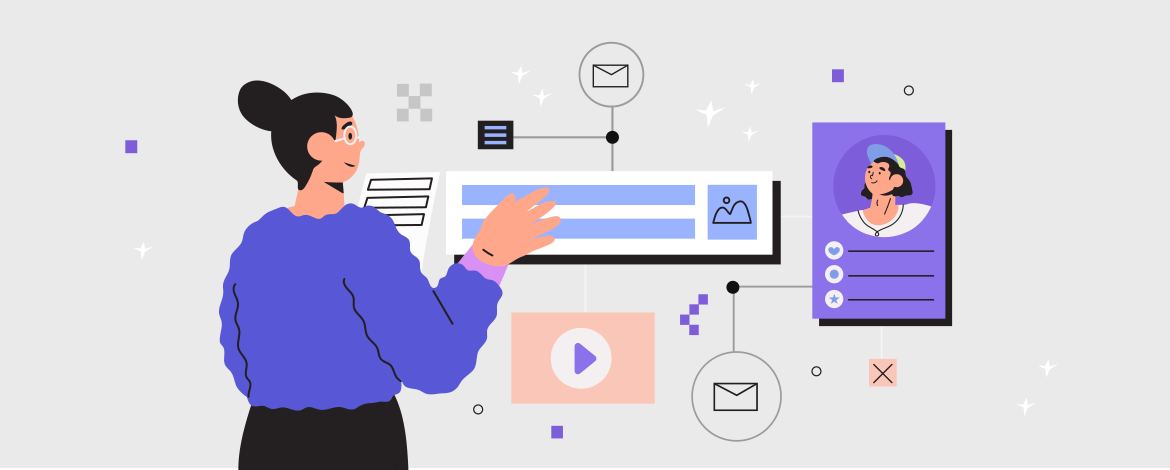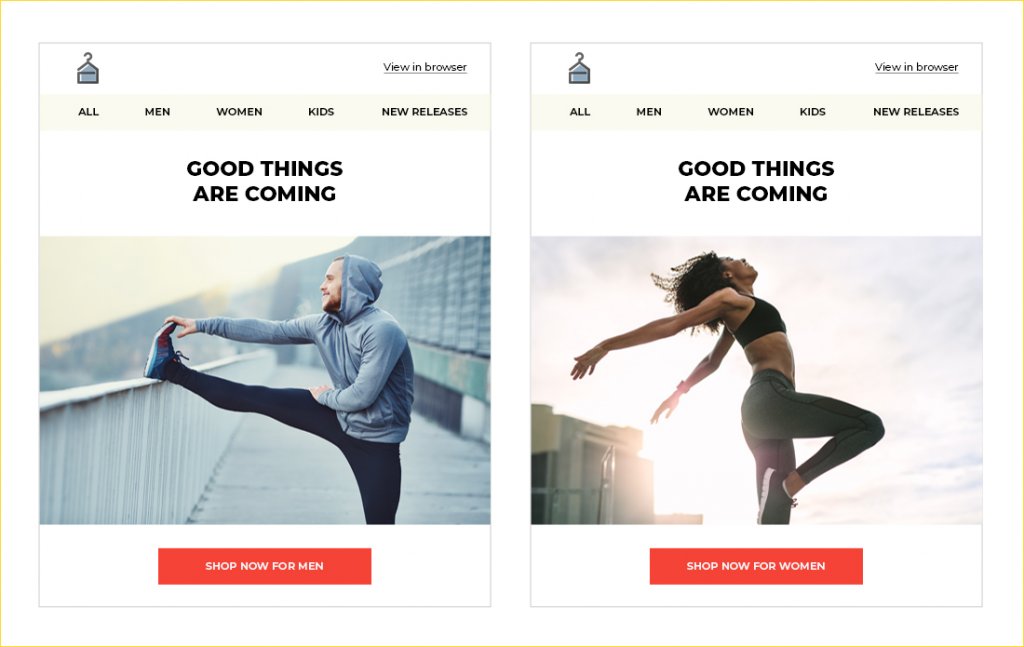Email continues to hold a special place in the marketing strategy for every business even with the rise of social media. The reason for this is that EMAIL is a permission-based marketing approach and the only channel that allows you to personalize your communications. No offense but I find social media posts similar to gatecrashing. Honestly, I have unfollowed so many brands just because their messages were not relevant to me. On the other hand, when someone subscribes to your email list, it is more like they have invited you to their place for dinner and you can send them targeted messages that they would be interested in.
If you are reading this, I am pretty sure you are aware of the basics of email personalization and how it works.
If not, check out our comprehensive guide to email personalization that you would certainly like to bookmark.
In this article, we will focus on advanced personalization techniques that will up your email marketing game and get you a higher conversion rate.
Let’s start…
1. Collection of data and third-party tools
If you have thoroughly exploited the personalization features available in your ESP, you must consider using third-party tools or a technology partner that would facilitate more elaborate personalization at scale.
First of all, you must spare enough time to understand the additional data you will need. Also, figure out the challenges you are facing with the current tool you are using and your expectations with the third-party software. The end goal for you must be to show your audience that you know them and accordingly deliver content that is most pertinent to their buyer’s journey. It would be a good idea to sit with your team members and brainstorm with them about the type of campaigns that would work the best for the subscribers. When selecting a third-party tool, research is of paramount importance. Choose the tools that are most compatible with the existing ones that you are using. If the tools come with pre-built integrations, you will be able to kickstart the advanced personalization strategy with new features sooner without exhausting your time and resources.
Tip: Get in touch with the account managers of your ESP, web platform providers, and other professionals who would help you with your data collection endeavors and the integration of third-party tools.
Take a look at some of the data collection and activation tools and ideas:
1. Social listening tools
Tools like Hootsuite and Buffer let you track what your customers are talking about and what they think about your brand.
2. Website analytics
Google Analytics and Hotjar are two of the best tools that allow you to understand the website visitors and how they are engaging with your content.
3. Mobile application analytics
Most businesses have an app in the present times. Mxpanel and Countly are two tools that can be used to collect subscriber data from mobile apps.
4. Sentiment analysis platforms
Powerful CRM tools like Salesforce have a feature known as Salesforce Einstein. It helps to recognize the feeling in text-based conversations. Other similar tools are IBM Watson, MonkeyLearn, and RapidMiner.
5. With the help of data management platforms (DMPs) like Clearbit and LiveRamp, you can gather data from your first-party digital domains, partner domains, and third-party tools. Subsequently, you can segment and integrate this data into the email platform.
Based on the data collected from these platforms, you can draft a relevant email copy that will be most useful for the reader. Just make sure that the tools can be integrated into your ESP.
Some other ideas to collect useful customer data are:
a. Have more detailed sign-up forms with additional fields that are relevant for your business. That’s the most straightforward way to collect data.
For example: If you are in the food industry, ask the subscribers what kind of cuisine they like the most.
b. Once a user signs up, you can ask him or her for more information through the emails. Nowadays, brands are experimenting with interactive emails with quizzes to understand their users better. You can use similar types of content to employ hyper-personalization.
c. In case you need more information about the send cadence and kind of emails your subscribers want to receive, you can take the help of preference centers. Ask the subscribers to set their preferences and send out emails accordingly.
2. Dynamic content in emails
If someone asks me about the oldest advancement in personalization, dynamic content would be the first thing to come to my mind. These emails have dynamic content blocks that change content and images based on the subscriber’s location, demographic data, needs, and interests. For example, you can send out summer arrivals to one segment and winter wear to another, considering their locations.
Here’s an example in which they have included a dynamic image as well as CTA button to promote relevant offers to men and women.
Furthermore, you can also send out dynamic product recommendations that can unfold exciting conversion opportunities.
i. Best-sellers
You can showcase the products that are the most popular among the customers. Besides facilitating your email personalization efforts, it will also serve as social proof and build trust with your customers. Once you set these dynamic product recommendations, it will not need any manual intervention and the campaigns will be automatically updated as per the trends.
ii. New arrivals
Most of the eCommerce stores regularly revamp their collections. Marketers can use dynamic blocks to send out new products added to the website. This will keep the email campaigns fresh without the need of coding them from scratch.
iii. “Frequently bought together”…
You can cross-sell complementary products considering the user’s browsing or purchase history. This data can be collected by analyzing the customer behavior and boost your average order value as users are tempted to add more products to their carts.
3. Predictive Analytics
Wouldn’t it be great if you had an expert astrologer revealing what kind of emails would work the best for your subscribers? Well, with the feature of predictive analytics, this dream can come true. Marketo and Salesforce are the most popular tools offering this functionality. Apart from these tools, some other ESPs and software programs also provide such analytics. The commonly included details are:
1. Level of purchase intent
Learning about the likelihood of a user making a purchase will enable you to set the cadence of your emails and their copy. You must focus more on the users with low purchase intent and send more frequent emails with incentives and personalized offers. On the other hand, subscribers with a high intent would convert even with a simple promotional email without any discounts.
The silver bullet is to experiment with different approaches and see what kind of tactics work the best for your brand. Considering these insights, you can avoid sending discounts to some segments of users, thereby increasing the average order value and net business profitability.
2. Predicted date of next purchase
Powerful ESPs will allow you to collate the buying habits of the users and predict the date of the next order. Based on this data, you can set an automation workflow that will trigger an email with product recommendations at the right time. Working on send-time optimization is also an important aspect of email personalization.
The same concept applies to stock replenishment emails that are automatically sent after a couple of months of the last purchase.
3. Favorite product category
Suppose you are sending out an email to expecting moms. Such emails would work better if you use imagery of expectant women that represents the target audience. Favorite product category works in the same way as it will allow you to package your emails in a way that appeals the most to the recipients.
4. Risk of churn
You can send out re-engagement emails and incentivize the users who are likely to get disengaged or almost dormant. That’s how the risk of churn parameter works.
5. Predicted lifetime value
Loyalty programs are one of the most effective ways to hyper-personalize your emails. Analyze the user’s purchase frequency, predicted date of next order, and history of past purchases. A detailed perusal of all these parameters will help you to predict the lifetime value. Accordingly, you can invite them to join your loyalty program which will, in turn, warrant better conversions for you. In addition, this information will also allow you to plan your nurturing email campaigns. For instance, if a user is predicted to spend around USD 200, you might need an incentive to convert them. Contrarily, a user who is likely to spend $500 or more, you can do away with those incentives and focus on profit.
If you want to understand your subscribers at a more granular level, predictive analytics is the best thing for you.
Related articles:
Email Personalization Advancements: The What, Why and How of Hyper-Personalization
How To Personalize Emails Beyond The ‘First Name’
Dos And Don’ts Of Email Personalization With SFMC
3. Data on Brand Engagement
When you acknowledge the customers for their interaction with your brand and how they have used your services over time, it will make them feel as if you know them personally. It will reflect that you care for your subscribers and strengthen your relationship with them.
“Your year in review” emails are the most popular way in which you can use brand engagement data to boost customer loyalty.
Recapitulate how your customers have used your products or services in the last year. For instance, if you are a non-profit organization, you can let your users know about the donations received in the last year, the causes contributed to, and the number of happy smiles it brought. It will let your customers know that they are an important part of your business and encourage them to contribute in the future.
Take a look at this email by Eventbrite in which they have showcased the meeting history throughout the year. It is really interesting how they have curated the statistics for the users.
Wrapping Up
If you are already using first name personalization and a few other tactics occasionally, you must start testing and optimizing your email campaigns with hyper-personalization tactics. In case you feel that you do not have enough resources and tools to scale your personalization ideas, you must think it over and consider investing in them.





Disha Bhatt (Dave)
Latest posts by Disha Bhatt (Dave) (see all)
The Beginner’s Guide To Working With SFMC Journey Builder
Dos and Don'ts of Email personalization with SFMC